Week 1 - Introduction to Cable Jointing - Manchester Courts, Airport, Tradefit
Today we were working at the demolition site of Manchester
 |
| After demolition |
I was working today with Ivor, Reece, Jeff and Jamie.
Connetics, being owned by Orion (Christchurch's electricity network owner) and having a staff complement of 250, has specialist digging crews and machinery. This is extremely useful as the cable jointing crews can concentrate on the jointing rather than have to dig holes.
We arrived onsite to the cables that needed joining being exposed. There were three 400 volt 3-phase PILCA-XLPE joints to be completed. PILCA is the term the jointers use for paper-insulated lead-covered armoured cable. XLPE stands for cross-linked polyethylene. XLPE is a far more 'modern' type of cable, of which the jointers have differing opinions. Some prefer the older type, and some prefer the newer type, but Orion decide what must be used.
Kits are once again used. However, outside of the kits' instruction, the PILCA join is done differently. Orion specify that 'lead wiping' must be done. This process is essentially soldering on a large scale. The reason that the guys told me the wiping must be done is that Orion want to preserve the skill, and a skill it is. The jointers take pride in their joints and even have wee 'competitions' on job as to who has doe the best wiping! The wiping itself is the act of preserving the insulation and hygroscopic integrity of the cable. The kit uses a type of copper 'spring wrap' as the equivalent.
Other parts of the kit include heat sink, which comes in specific shapes, different types of insulating tape, the mechanical lugs with 'shear bolts', void filler, and copper mesh tape.
Other parts of the kit include heat sink, which comes in specific shapes, different types of insulating tape, the mechanical lugs with 'shear bolts', void filler, and copper mesh tape.
 |
| Original PILCA cables |
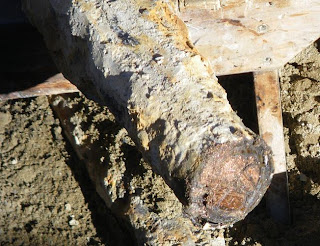 |
| After cutting |
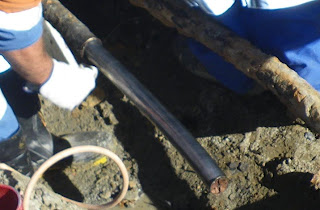 |
| After removal of steel armour and pitch layers |
 |
| After lead removal before wiping. Measurements done and heatshrink installed. |
 |
| Post-wiping |
 |
| Shrinking 'breakout boot' onto joint |
 |
| Individual joints done |
 |
| Installing copper mesh tape to maintain earth shielding |
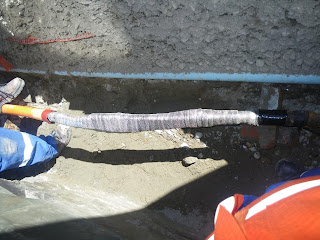 |
| Copper mesh tape installed and taped |
 |
| Finished joint post-earthing connection |
During the jointing, I was able to observe the installation of a light pole (low-pressure sodium vapour lamp) by the streetlighting crew, who I will be spending time with later.
I also did three joints of a PILCA-XLPE joint under Reece's supervision. Enjoyed getting in there and getting involved! A good piece of advice Reece gave me.. ‘measure twice, cut once’. Makes sense!
Once completed and tested, the joints are covered with crusher dust. The council organises the final covering (footpaths, etc.).
Wednesday 2nd February
This day was split into two; I was at Christchurch Airport in the morning, and the CPIT Tradefit substation in the afternoon.
At the airport I observed an 11kV-11kV PILCA-XLPE transition joint (getting the jargon now!)
There was a very strong northwest wind blowing, which created particle and dust hazards, which made life difficult.
11,000 volt joints, as opposed to 400 volt joints take longer, as the cable is different, having additional layers in the insulation such as semiconductor, which reduces eddy currents in the shielding.
 |
| End 11kV XLPE cable |
 |
| First layer insulation stripped off |
 |
| CANNOT forget to put the heatshrink on! |
 |
| Stripped back PILCA and earth straps attached |
 |
| Lead wiping PILCA |
 |
| Boot on |
 |
| Shrink boot in place |
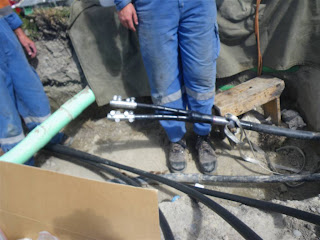 |
| Terminals on |
 |
| Nice cross section PILCA |
 |
| Joiner kit designation |
 |
| Semiconductor layer stripper |
 |
| Mating the cables |
 |
| Adding 'void filler' |
 |
| Terminal heatshrink |
 |
| Shrinking |
 |
| Shrunk! |
I was taken to my next job before I could get earthing and finished pics..!
CPIT Tradefit afternoon and Thursday all day
The 33kV Tradefit site at CPIT Ensors Rd campus has been donated by industry and will be used by industry for training. This installation needs to be finished soon as there is lines competitions there in April.
I was working with Ivor and Steve at the site, which involved the termination of 11kV cables into large switchgear in the substation.
We discovered a 400 volt cable had been left out in the sun uncovered and had its outer insulation failing to UV radiation. I organised it to be covered ASAP.
Steve and I also cut some extra cable from massive drums, making sure to re-cap them when we finished. The measuring of the cable run and the cables were done with fibreglass tape measure to be as flexible as possible around corners.
 |
| Plans for the substation |
 |
| Circuit breakers that were connected at the back |
 |
| Circuit protection |
 |
| Terminal lugs-there are boots to go on the tops, but are being left off until testing has been done. |
 |
| Rotary strippig tool |
 |
| Finished stripping |
 |
| Cutting floor panels to make running the cable underneath easier. |
 |
| HV Switch |
Highlights of the day;
Steve's tip- When connecting into substation circuit breakers- ‘red right rear’ this enables the front of the breaker has correct phasing red/white/blue.
During the day, the 'test room' guys came along and tested the phasing and continuity of the circuits using an ingenious system of batteries. R-W 3 volts, W-B 6 volts, B-R 9 volts. Clever!
Friday 4th February
Friday 4th February
Unfortuately I became sick Thursday night and wasn't able to attend work Friday.

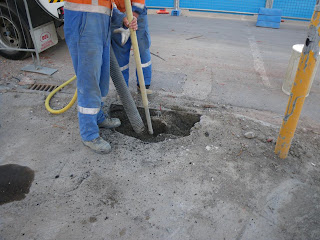






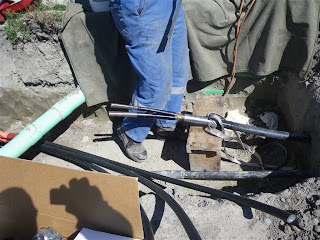






Comments
great photos :)
Will you be thinking of having your students use a blog to record their own learning during the course??
Keep in touch, Selena
It's a nice idea, but I think they'll only be short courses and they won't have time. But it'll be worth a try!